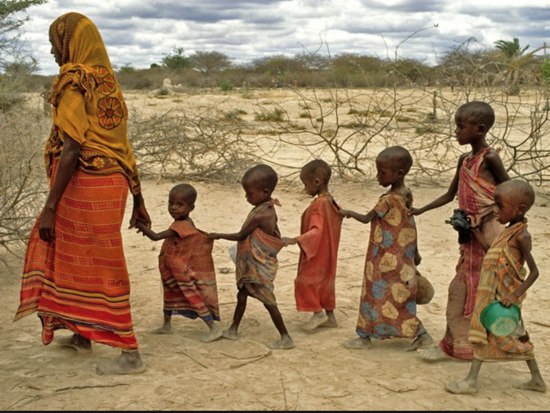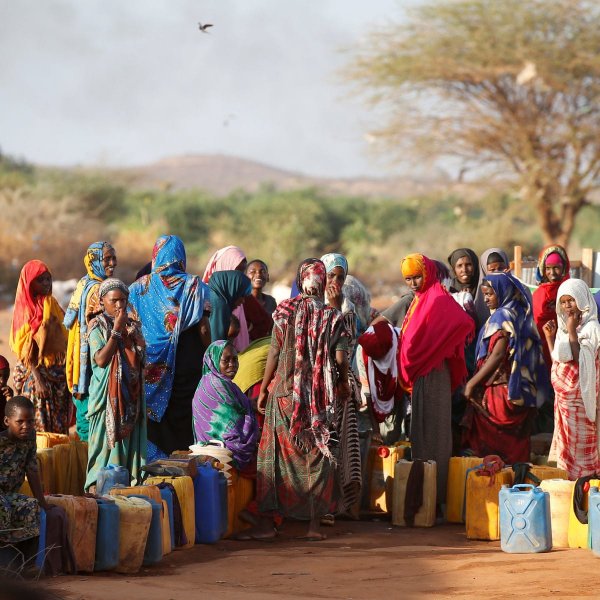Forgotten Crises
Until just a few years ago, forgotten crises were actually climatic shocks like floods, droughts, and storms. These were phenomena considered likely but unlikely to occur in most parts of the world, depending on the geographical location of countries and regions. A generation might witness their occurrence once or twice.
However, for nearly two decades, the use of the term unlikely to describe these phenomena has gradually lost its meaning. In the new norm we live in today, climatic shocks with high intensity and impact have turned into very likely, if not common, occurrences due to human presence in vast areas of the planet Earth.
Recently, we witnessed an example of this in Pakistan and India, where both countries were affected by an unusual heatwave for several months. Shortly after this heat, we saw sudden floods that submerged one-third of Pakistan.
Similarly, in African countries like Sudan and South Sudan, deadly floods with varying intensity affect thousands of lives each year. In Central America, they are increasingly falling victim to severe storms.
But perhaps no region can illustrate this new norm as well as the Horn of Africa. After four consecutive years of drought, with a fifth year expected, it is fair to ask whether this has become a norm today and whether witnessing a rainy season similar to those that were once common and considered normal has become an exception.
The answers to such questions are critical not only for the food security of the populations living in these areas but also for organizations like the World Food Programme (WFP) that deal with food security worldwide.
Five consecutive years of drought bring consequences far beyond severe food shortages. In fact, its impact is on investment in sustainability models for local communities and economies that have persisted for centuries and now find themselves forced to confront a rapidly changing territory and climate. This situation has very tangible consequences for local institutions, especially in areas with very high unemployment rates where agriculture has always been the occupation of the vast majority of the population.
Likewise, for the rulers of countries often considered with very fragile macroeconomic frameworks, they have been forced for years to find additional resources for food imports to compensate for the minimal domestic production, thereby strengthening their dependence on foreign countries. Consequently, in times like today, when faced with skyrocketing international prices, the economies of these countries become extremely vulnerable.
The New Norm in Somalia
Although in most states of the Horn of Africa, recent years’ climatic shocks have exacerbated local socio-economic and political fragilities, perhaps none have been as deeply affected by the impact of such shocks as Somalia. A country already struggling with high levels of poverty and prolonged conflicts.
One of Africa’s poorest states, where 61% of the population lives on less than $1.90 a day, Somalia has been embroiled in political instability since its independence. From the 1990s, it became the scene of numerous internal conflicts at both local and national levels. Additionally, since the mid-2000s, the country has faced an insurgency by the fundamentalist Islamic group Al-Shabaab, which has intermittently managed to expand its control over large areas of the country.
Such an image, characterized by severe poverty and significant institutional fragility, has made this country remarkably vulnerable to the extent that it is unable to devise effective measures to combat potential emergencies. As a result, it has become much more fragile and vulnerable to the impacts of climatic shocks in recent years.
This issue became dramatically evident during the famine of 2011 and 2012, when, due to two consecutive years of drought, more than 250,000 people lost their lives. On that occasion, the Integrated Food Security Phase Classification, commonly known as IPC, which is a multilateral initiative launched in 2004 by some United Nations agencies to effectively gather and classify information on food security in critical areas, accessed sufficient data to sound the international alarm only when it was estimated that half of the famine’s total victims had already died. This demonstrated that the crisis had progressed. However, subsequent widespread and sudden international intervention managed to halt the crisis and prevent millions of additional victims.
2022 and the Threat of Famine

To officially declare a famine outbreak in a country requires the extensive activation of economic resources and the institutions of the United Nations and the international community. The criteria for officially declaring a famine include the following:
1. When at least 20% of households in a specific area are experiencing severe food shortages, meaning they are unable to provide a full meal for a full day and more than one day a week.
2. When at least 30% of young children are suffering from acute malnutrition, and the mortality rate due to hunger or hunger-related diseases is at least 2 per 10,000 people.
Therefore, officially declaring a famine is not an easy decision and can only be made after a thorough review of existing data and information by a special commission of experts known as the Famine Review Committee (FRC) to prevent the process of collecting and processing information for an international mobilization call from leading to another deep crisis occurrence.
Like what happened in 2011, in the past decade, the IPC has created an early warning system capable of using current available data with a reasonable degree of probability to estimate the possibility of a famine occurring in the coming months. This aims to allow the United Nations and the international community to organize and prepare necessary actions in a timely manner.
This is exactly what has been implemented today regarding Somalia. After the 2011 disaster, a significant amount of resources has been made available to this country by the international community for humanitarian support to local people to address the unprecedented situation it faces today, namely four consecutive years of drought, with evidence unfortunately suggesting that the addition of another year to this period seems inevitable.
The second annual rainy season, which in this country corresponds to the months of October and November, once again appears to be very limited and negligible in terms of rainfall. The human situation is currently deteriorating dramatically, especially in the Gulf regions of Bay, Bakool, and Buur Hakaba in the Somali Gulf, which are at greater risk.
Meanwhile, despite the fact that the country’s general elections were held relatively peacefully last May, government institutions are extremely weak and unable to tackle the impending emergencies. Ultimately, the extremist group Al-Shabaab now controls vast areas in the Gulf region, making access for humanitarian organizations to these areas very difficult.
Famine Budget Shortage and Financial Resources
But what truly complicates and dramatizes the situation, according to IPC analysis, is the significant reduction in available budgets for humanitarian organizations active in this country. The World Food Programme in Somalia has not had enough resources for some time to meet the needs of all those in need. According to the latest CPI forecast for the period from October to December 2022, around 6.7 million people in the country will suffer from food insecurity, with approximately 301,000 of them at risk of real famine.
In response to these figures, the World Food Programme doubled its operational capacity in August compared to April and managed to reduce the number of people facing a food crisis to 4.4 million, thereby providing necessary assistance to those in more dire conditions. However, due to insufficient funding, this effort cannot continue beyond October.
The gap between existing needs and financial resources is not due to a decrease in international community financial aid. On the contrary, in recent years, international solidarity in response to food crises, including the Somali crisis, has increased. Unfortunately, the reason for this gap is that the number of people in need of humanitarian aid is rapidly increasing.
The pandemic, increasing climatic shocks, and rising prices of agricultural and energy raw materials have indeed led to a sudden increase in food insecurity worldwide, which international solidarity continues to strive to combat.
In 2022, the World Food Programme (WFP) has so far received $947 billion from international donors. However, this amount is not sufficient to cover the needs of hundreds of millions of people estimated to be experiencing food insecurity worldwide.
Somalia reproduces this dynamic on a smaller scale. Despite the fact that international solidarity with this country has significantly increased since the 2011 famine, the doubling of the World Food Programme’s operations in this country has become necessary due to the worsening climatic conditions this year, leading to a rapid depletion of available financial resources.
According to existing estimates, the World Food Programme needs to receive an additional $367 million from the international community to extend its activities under the current regime until February 2023, with the hope that during this time, a slight improvement in the country’s situation will be observed.
The simultaneous occurrence of several factors worsening the situation in Somalia, the significant increase in the number of people at risk due to drought, political instability, and insufficient financial resources available to humanitarian organizations in relation to the country’s needs, led the IPC to formally warn of the risk of famine outbreak starting this fall.
It also announced the possibility of worsening conditions in the first half of 2023. According to this organization’s warning, the number of people at risk will be more than three times the victims in 2011.
The United Nations immediately launched a fundraising campaign to at least minimize and limit the impact of the financial shortfall as much as possible. Despite some initial positive results, unfortunately, the gap between available financial resources and the required amount remains a significant figure, while time is running out.
Other articles on this topic have been published on Iran Gate.
Predicting Water Wars in Iran
- Weather and Environment in Times of War

